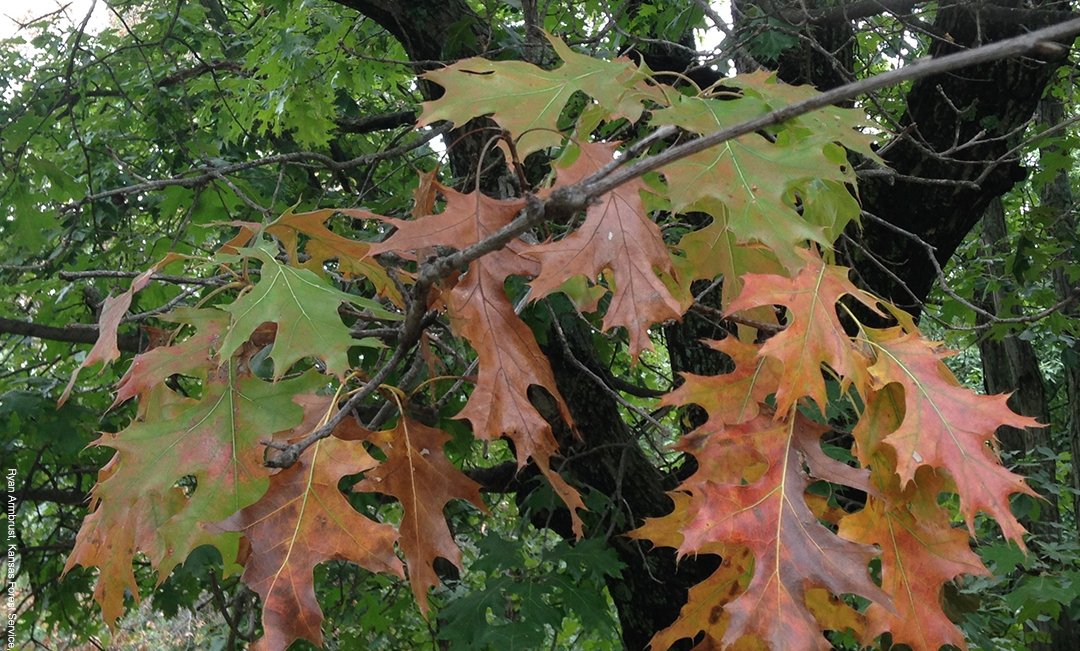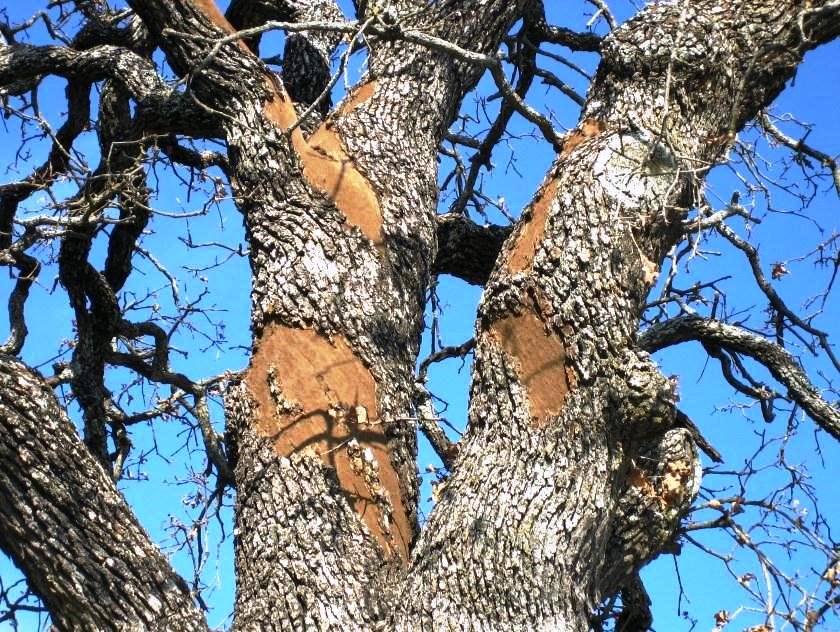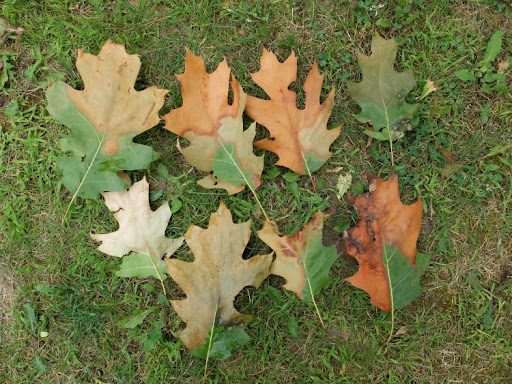What is Oak Wilt?
Oak Wilt is a fast-moving, highly destructive fungal disease that targets oak trees and it’s especially aggressive in the red oak family. Caused by Bretziella fagacearum, this fungus invades a tree’s vascular system, cutting off the flow of water and nutrients until the tree wilts, browns, and ultimately dies. In many cases, healthy red oaks can go from full canopy to fatal decline in just a matter of weeks.
This disease is more than just a threat to individual trees, it’s a neighborhood-wide concern. Oak Wilt spreads both above ground through beetles that are attracted to fresh tree wounds, and underground through root grafts that connect nearby oaks. That means one infected tree can quickly become a source of infection for many others.
What Does Oak Wilt Look Like: The Signs You Might Have It
Catching Oak Wilt early can be the difference between saving a tree and losing an entire row of oaks. The disease progresses quickly, especially in red oaks, so it’s crucial to know what to look for. Symptoms can vary depending on the oak species, in fact, white oaks tend to show a slower progression of symptoms and may survive for several years if the disease advances slowly, but there are key warning signs to watch for.
Here’s what to look out for:
- Sudden leaf wilting and browning, often starting at the top of the tree and moving downward
- Leaves turning dull green, bronze, or brown, usually with discoloration starting at the leaf edge and moving inward
- Premature leaf drop—even in mid-summer when foliage should still be healthy
- Dead branches in the upper canopy, sometimes with a clear line between healthy and affected areas
- Dark streaks beneath the bark (visible when bark is peeled back), showing internal vascular damage
- Fungal mats (in red oaks), which can form under the bark and give off a strong, sweet odor
- Rapid decline—red oaks can die within 4–6 weeks of first symptoms appearing
How Bur Oak Blight Spreads to Other Trees
One of the reasons Oak Wilt is so dangerous is because of how easily it can spread from one tree to another, both above ground and below the surface. Understanding the different ways the fungus moves through a landscape is key to stopping its progression and protecting nearby trees.
Oak Wilt primarily spreads through two main pathways:
- Underground through root grafts
- Oak trees growing close together—especially within 50 feet—often have roots that naturally graft together.
- If one oak becomes infected, the fungus can travel directly through these root systems to neighboring trees.
- This type of spread is common in oak-heavy neighborhoods and forests.
- Above ground via sap-feeding beetles
- Tiny beetles (especially in the Nitidulidae family) are attracted to fungal mats that form beneath the bark of infected red oaks.
- These beetles pick up fungal spores and then carry them to fresh wounds on healthy trees—usually caused by pruning, storms, or broken limbs.
- The risk is highest during spring and early summer when beetle activity and tree sap flow are at their peak.
Other ways the disease may spread:
- Moving infected firewood
- Logs or firewood from infected trees can harbor the fungus, especially if they contain fungal mats under the bark.
- Transporting or storing this wood near healthy oaks can increase the risk of spread.
- Improper pruning at the wrong time of year
- Pruning during high-risk seasons (typically April through July in Missouri) leaves open wounds that attract beetles carrying Oak Wilt spores.
- Best practices recommend avoiding oak pruning during these months unless absolutely necessary.
Common Trees in Missouri at Risk from Oak Wilt
Missouri’s oak population is diverse, but not all oaks respond the same way to Oak Wilt. Some are highly vulnerable and die quickly, while others may show slower symptoms or resist infection altogether. Here’s a breakdown of the most common local species and how they’re affected:
Highly Susceptible – Red Oak Group
- Northern Red Oak
A fast-growing shade tree common in Missouri. Once infected, it typically dies within weeks. Known for forming fungal mats that accelerate disease spread.
- Pin Oak
Popular in urban landscaping but extremely vulnerable to Oak Wilt. Rapid canopy dieback is often the first symptom.
- Shumard Oak
A stately oak often planted in lawns and parks. Like other red oaks, it has a wide vessel system that allows the fungus to move quickly.
- Black Oak
Found in both forests and residential areas. These oaks decline rapidly after infection, often within one growing season.
Moderately Susceptible – White Oak Group
- White Oak
A Missouri native with stronger disease resistance. The fungus spreads slowly in white oaks, allowing time for treatment if caught early.
- Bur Oak
Common in both woodlands and urban parks. Though part of the white oak group, Bur Oaks are susceptible to related diseases like Bur Oak Blight and can also be affected by Oak Wilt.
- Swamp White Oak
Grows well in low-lying, wet areas. Shows more resilience than red oaks but is still at risk, especially in stressed environments.
- Chinquapin Oak
A less common but valuable species in native landscapes. Its tighter vascular system slows the progress of infection.
Variable Susceptibility – Other Oaks & Hybrids
- Post Oak
Often found in rocky soils and open woodlands. Shows some resistance to Oak Wilt but may still decline if stressed.
- Southern Red Oak
More common in southern Missouri. It falls within the red oak group and is therefore considered at high risk.
- Oak Hybrids
Natural or cultivated crosses between oak types can vary in susceptibility. The more red oak genetics they carry, the more vulnerable they tend to be.
Treatment and Prevention for Oak Wilt
Oak Wilt is a serious and fast-moving disease, especially in red oaks, so proactive prevention and early intervention are critical. While there’s no guaranteed cure once a tree is severely infected, certified arborists can often help slow the spread and protect nearby trees with proper management.
Treatment Options
- Trenching to Sever Root Grafts
One of the most effective ways to stop Oak Wilt from spreading underground is by installing a trench between infected and healthy trees. This severs root grafts—natural underground connections between nearby oaks that allow the fungus to move from tree to tree.
- Fungicide Injections
Systemic fungicides, such as propiconazole, can be injected into the base of high-value white or bur oaks that are not yet showing symptoms. This is often used as a preventative measure or to slow progression in lightly affected trees.
- Selective Tree Removal
If a red oak is already infected and declining, oak tree removal may be the best option to prevent spread. It’s important that infected wood is handled correctly—either burned, chipped, or properly sealed—so beetles don’t spread spores to other trees.
Prevention Methods
- Avoid Pruning During High-Risk Months
Never prune oak trees from April through July, when sap-feeding beetles are most active. Open pruning wounds attract beetles that can carry Oak Wilt spores. Schedule pruning in the late fall or winter when beetle activity is minimal.
- Proper Wound Care
If an oak tree is accidentally wounded (from storm damage, lawn equipment, etc.), immediately seal the wound with tree wound paint. While this isn’t typically recommended for most trees, it’s important for oaks at risk of Oak Wilt.
- Don’t Move Firewood
Avoid transporting firewood from oak trees unless it has been properly dried and cured. Oak Wilt can survive in infected wood, and moving it may introduce the disease to new areas.
- Regular Health Inspections
Annual evaluations by a certified arborist can catch early signs of Oak Wilt, allowing for quicker action and potentially saving surrounding trees.
Plant Resistant Dogwood Varieties:
- Consider planting Kousa dogwood (Cornus kousa) or disease-resistant hybrids like the Stellar series (‘Aurora’, ‘Ruth Ellen’, ‘Constellation’) in high-risk areas.
- These varieties offer similar visual appeal with significantly stronger resistance to anthracnose.
Protecting your oak trees starts with early detection and expert care. If you suspect Oak Wilt or simply want peace of mind, our certified local arborists at Ballwin Tree Service are here to help. We’ll assess your tree’s health, identify potential risks, and guide you through the best steps to preserve your landscape. Schedule your free tree health inspection today and safeguard your property for years to come.



